
Is an Ultrasound Scan a Missing Piece in the Fertility Puzzle?
Patients are Desperate for a Diagnosis

Read how one patient insisted on a 3D transvaginal ultrasound scan when it came to choosing her OBGYN.
Twins run in Brittany family. Her grandmother had a twin sister, and everyone joked that Brittany would be seeing double in her future, too. She’d sometimes think about the odds of having two babies, not knowing she’d suffer through years of heartbreak—just wishing for one.
“It never even entered my mind that it would be difficult, or that we’d struggle with fertility problems. We were completely unprepared for what was in store for us,” Brittany said.
In five years, the couple endured five miscarriages. And with every loss, it became harder and harder to face family and friends, who didn’t know about their private pain. It was the same questions—over and over. When are you going to have kids? What are you waiting for?
It turns out, Brittany was waiting for a diagnosis. A friend, who worked at GE, asked if she’d ever had a 3D ultrasound. She did some research and found a specialist with a Voluson™ machine. The 3D scan revealed a septate uterus—the most common uterine anomaly, linked to the poorest reproductive outcomes.
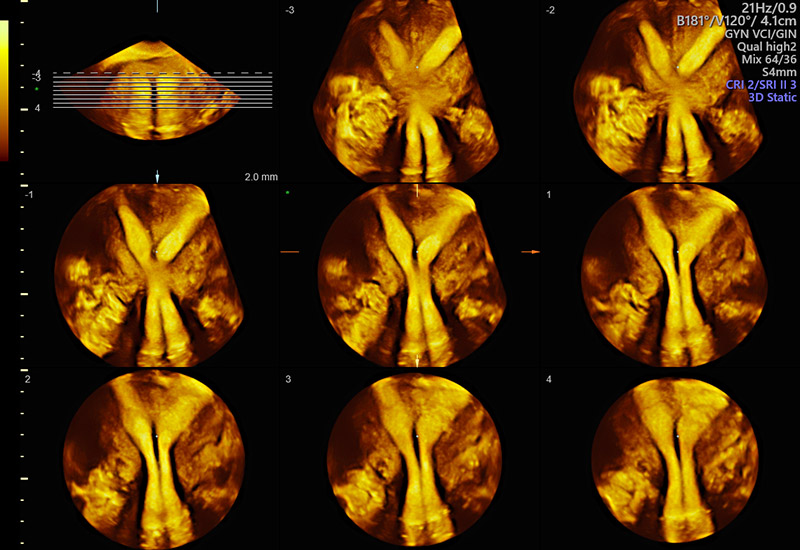
Uterine anomalies such as this Septate Uterus are readily seen with Voluson 3D ultrasound.
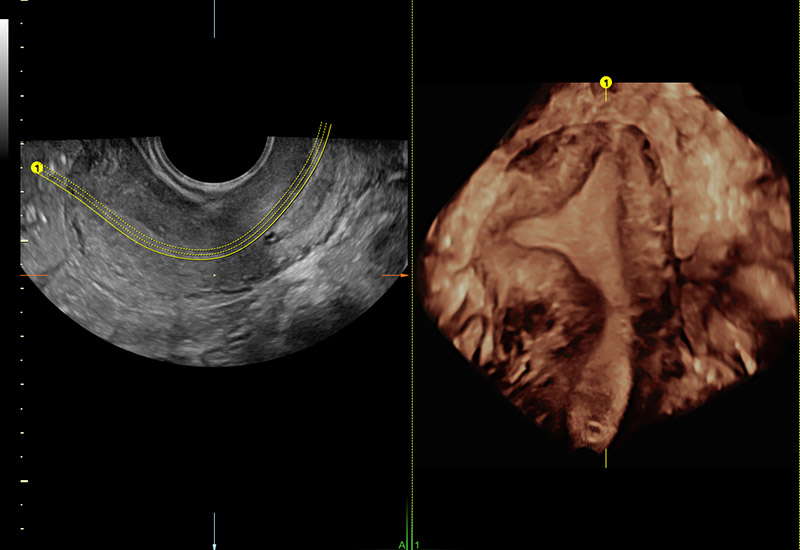
Voluson 3D tools such as OmniView help detect uterine shape anomalies that can impact conception.
“I had never even heard of a 3D ultrasound and I talked to several doctors. No one really did any diagnostic testing,” Brittany said.
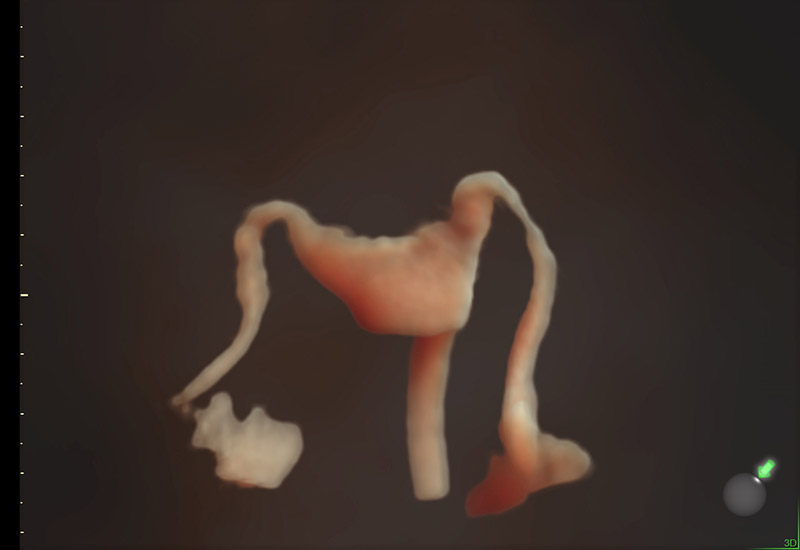
Confirmation of non-blocked fallopian tubes seen with Hysterosalpingo Contrast Sonography*.
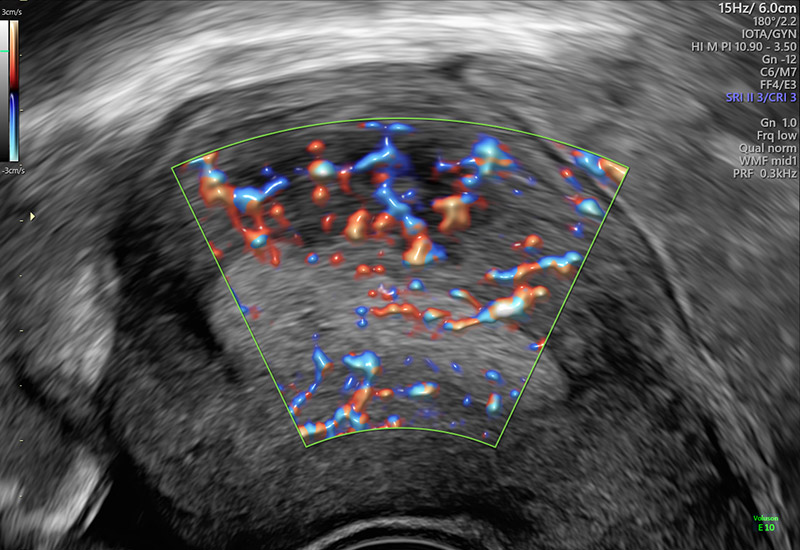
Highly sensitive color Doppler is needed to detect presence of bloodflow within the endometrium.
“You hear that so many miscarriages are unexplained. After living it, I wonder how many women in my situation have had a 3D ultrasound.”
That diagnosis led to an important surgery and eventually IVF. Knowing it was their best shot at having a baby, Brittany and her husband let science take the lead. At 35 years-old, Brittany was pregnant again and hoping against hope that her dream of being a mother would finally come true. But within months, her father passed away and a heartbroken Brittany miscarried again. With two embryos left, the couple had a hard decision to make: try again, knowing it could end in more pain. Or walk away.
“We didn’t really talk about IVF with family because we knew everybody would have an opinion—and we didn’t want to have that conversation,” Brittany said. “They had no idea what it was like, and we just wanted to get through it.”
On Brittany’s 10th wedding anniversary, the couple found out she was pregnant. From that point on, she started searching for physicians with GE ultrasound systems—insisting the technology was part of her care. She even switched OBGYNs in her second trimester because her doctor didn’t use Voluson.
“I wanted to make sure I was being scanned on the best possible equipment.” She added, “For me it comes down to: if you can see more, you can treat more. I think technology is a huge, huge part of a practice.”
Patient experience is also at the top of her list. Having a 3D ultrasound in her physician’s office saved Brittany valuable time—especially since her pregnancy was considered ‘high risk’ and she required regular scans.
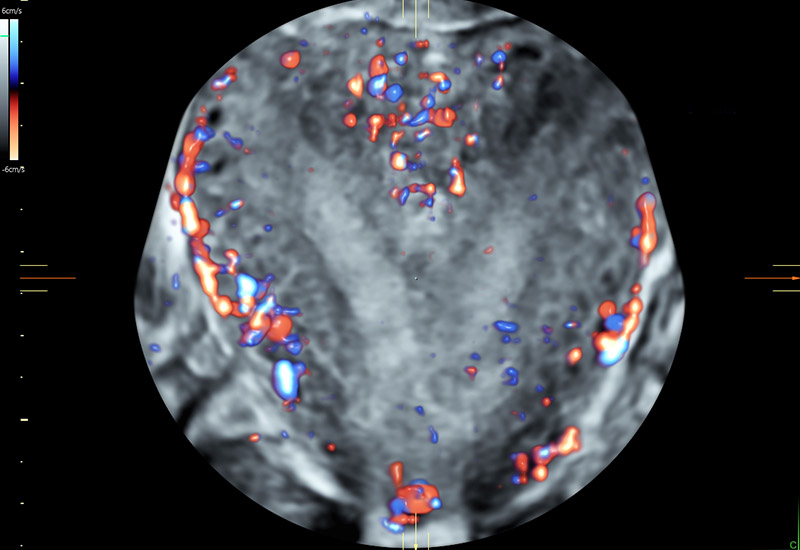
3D Glass Body aids in the location of blood vessels for surgical planning.
Last year, Brittany got her happy ending with the birth of not one, but two baby girls. Twins—just like everyone predicted. But the role of technology in her desperate journey to become a mother isn’t lost on Brittany.
“What if I never had that 3D scan? Would I have my two girls? Yes, my grandma was a twin, but my babies are IVFs…they’re science babies. I’m just fortunate enough to live in a time where this can happen.”
-
Fertility can be a concern for people in their reproductive years, as these patients may have questions about diagnoses, treatments and causes of infertility. Learn about some of the causes, diagnostic test and treatment options available to patients. What to Know About The Causes of Infertility, Evaluation and Treatment.
-
A Voluson 3D transvaginal ultrasound offers real advantages when screening for infertility symptoms. Learn how Dr. Hanson manages fertility testing and sign up to Stay Informed. Understanding infertility symptoms before the disease.
-
Using pelvic ultrasound to screen the female reproductive organs for structural causes of infertility is one of the best first steps when beginning an infertility assessment. Voluson 2D and 3D ultrasound is used to assess uterine shape, size and provides views that allow you to assess for normal anatomy or pathology. Learn more about how Voluson can help enhance communication with your patients. What is infertility? What patients want to know.
-
Learn about why Dr. Hanson feels that HyCoSy is the simpler, safer, more informative test of choice for determining tubal patency during a transvaginal ultrasound exam. Not just alphabet soup: get cozy with HyCoSy.
-
3D ultrasound enables physicians to build strong relationships with their patients by anticipating possible congenital uterine anomalies in women with infertility or repeat adverse pregnancy outcomes. What You Should Know About Congenital Uterine Anomalies.
-
Learn more about how Voluson ultrasound systems continually push the boundaries of Reproductive Medicine imaging to give you simple, yet innovative tools to help you and your patients achieve their dream of a successful pregnancy.
-
An estimated one in four couples worldwide are affected by infertility. While infertility is rarely considered a national health priority by governments, its impact on the lives of individuals, couples and their families who experience problems having children are enormous. The development of Assisted Reproductive Technologies (ART) is gradually transforming the range of options available to couples and individuals, bringing hope to millions. The WHO gives insights with this IFFS Surveillance 2016 report about the opportunities and challenges facing expansion of ART services.

